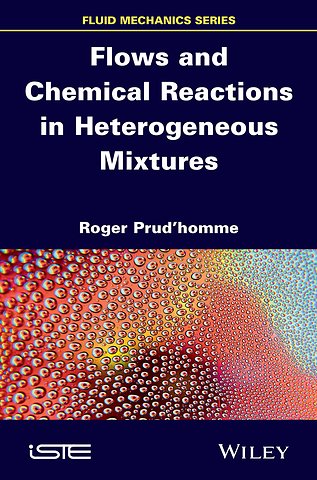Flows and Chemical Reactions in Heterogeneous Mixtures
Gebonden Engels 2014 9781848217850Specificaties
Lezersrecensies
Inhoudsopgave
<p>LIST OF MAIN SYMBOLS xv</p>
<p>CHAPTER 1. GENERATION OF MULTIPHASE FLOWS 1</p>
<p>1.1. Creation of suspensions of solid particles in a gaseous phase 1</p>
<p>1.1.1. Creation of a homogeneous suspension of starch particles 2</p>
<p>1.1.2. Soot formation 3</p>
<p>1.2. Creation of suspensions of bubbles in a liquid 5</p>
<p>1.2.1. Example of creation of a suspension of bubbles in a liquid 5</p>
<p>1.2.2. Influence of gravity on suspensions in pipes 7</p>
<p>1.2.3. Slug flows 8</p>
<p>1.3. Creation of suspensions of drops in a gas 9</p>
<p>1.3.1. Destabilization of fluid sheets and layers 10</p>
<p>1.3.2. Formation of droplets from filaments 22</p>
<p>1.3.3. Numerical simulation of primary atomization 32</p>
<p>1.3.4. Secondary atomization 42</p>
<p>CHAPTER 2. PROBLEMS AT THE SCALE OF A PARTICLE 47</p>
<p>2.1. Force exerted by a fluid on a spherical particle 48</p>
<p>2.1.1. Perfect incompressible fluid 48</p>
<p>2.1.2. Incompressible viscous fluid 51</p>
<p>2.2. Heat exchanges 59</p>
<p>2.3. Combustion of a drop of fuel in an oxidizing environment 61</p>
<p>CHAPTER 3. SIMPLIFIED MODEL OF A NON–REACTIVE FLOW WITH PARTICLES 65</p>
<p>3.1. Variables characterizing the flow 66</p>
<p>3.2. Balance equations 68</p>
<p>3.2.1. Balances for the particles 69</p>
<p>3.2.2. Balances for the gaseous phase 71</p>
<p>3.2.3. Entropy balance and phenomenological relations 71</p>
<p>3.3. Application to the linearized study of sound propagation in a non–reactive dilute suspension 74</p>
<p>3.4. Two–phase dilute flows in nozzles 78</p>
<p>3.4.1. Flow with constant phase shifts 79</p>
<p>3.4.2. Numerical solutions 82</p>
<p>CHAPTER 4. SIMPLIFIED MODEL OF A REACTIVE FLOW WITH PARTICLES 85</p>
<p>4.1. Balance equations for a reactive fog 85</p>
<p>4.1.1. Balances for the droplets 86</p>
<p>4.1.2. Balances of the mixture 88</p>
<p>4.1.3. Gaseous balances 90</p>
<p>4.1.4. Entropy balance of the spray and phenomenological relations 90</p>
<p>4.1.5. Equations of the two–phase CEDRE solver 92</p>
<p>4.1.6. Modified equations to take account of an internal temperature gradient of the drops: multi–layer model 93</p>
<p>4.2. Application to a spray flame 98</p>
<p>4.2.1. Application of a minimum model to the study of the threshold of appearance of a pulsating flame 98</p>
<p>4.2.2. Application to the study of the resonant action of an acoustic wave on a spray flame 102</p>
<p>CHAPTER 5. RADIATIVE PHENOMENA 105</p>
<p>5.1. Basic values and fundamental relations in radiative transfer 106</p>
<p>5.1.1. Definitions 106</p>
<p>5.1.2. Radiative Transfer Equation (RTE) 108</p>
<p>5.1.3. Radiative flux and power 110</p>
<p>5.1.4. Involvement of radiative heat transfer in the equations of aerothermochemistry 113</p>
<p>5.1.5. Turbulence radiation interaction (TRI) 118</p>
<p>5.1.6. Modeling of the radiative properties of gases 119</p>
<p>5.1.7. Modeling of the radiative properties of the particles 124</p>
<p>5.2. Application to the hypersonic flow of atmospheric re–entry 127</p>
<p>5.2.1. One–dimensional approximation for a re–entering body 128</p>
<p>5.2.2. 3D calculations for a body experiencing re–entry 130</p>
<p>5.3. Application to the boundary layer above a flat plate with soot formation and radiative transfer 132</p>
<p>5.3.1. Recap on a boundary layer with diffusion 133</p>
<p>5.3.2. Reminders about the Emmons problem 136</p>
<p>5.3.3. Influence of soot and radiative transfer 142</p>
<p>5.4. Application to combustion of aluminum–based solid propellants 144</p>
<p>APPENDIX. CONCEPTS SURROUNDING THE HOPF BIFURCATION 149</p>
<p>BIBLIOGRAPHY 153</p>
<p>INDEX 173</p>
Rubrieken
- advisering
- algemeen management
- coaching en trainen
- communicatie en media
- economie
- financieel management
- inkoop en logistiek
- internet en social media
- it-management / ict
- juridisch
- leiderschap
- marketing
- mens en maatschappij
- non-profit
- ondernemen
- organisatiekunde
- personal finance
- personeelsmanagement
- persoonlijke effectiviteit
- projectmanagement
- psychologie
- reclame en verkoop
- strategisch management
- verandermanagement
- werk en loopbaan

